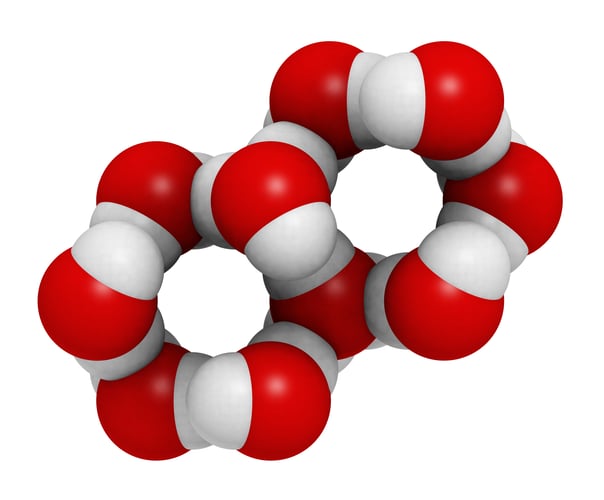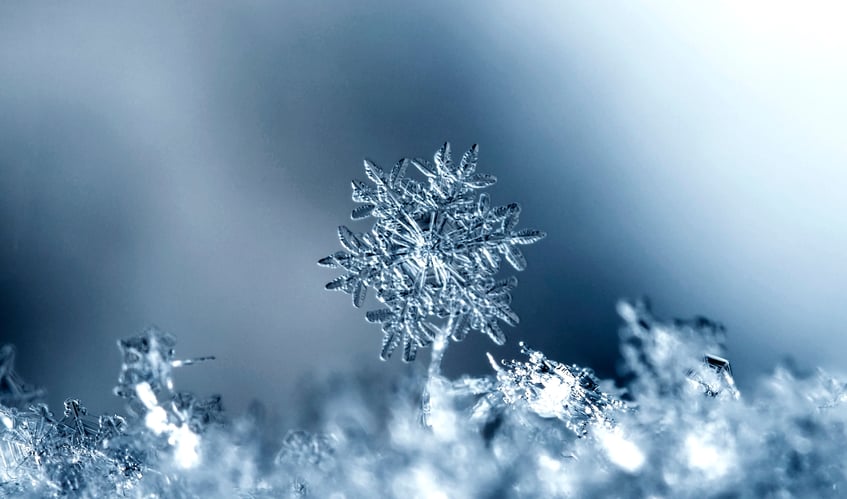The words still echo in my mind: “If you remember one thing from this class, remember that water is polar.” My high school biology teacher, Mr. Loftin, must have said it a hundred times each year. His classroom of sophomores inevitably rolled their eyes—and yet something about his relentless refrain broke through my antagonistic teenage tendencies and challenged my contrarian assertion that school was probably a waste of time. Why did a biologist care so deeply about this chemical tidbit? Was it some 100-point question on the final test, or could such a small thing have real consequence?

Water molecules, made up of 2 hydrogen atoms and 1 oxygen atom, bond with other water molecules readily because of their polarity.
You won’t be surprised to learn that Mr. Loftin knew what he was talking about. At every scale, from ecology to cellular biology, life on Earth hinges on the unequal sharing of electrons by oxygen and hydrogen atoms. Although these atoms join into a water molecule with an overall neutral charge, oxygen has just a little bit more pull on the electrons. That makes the molecule negative on one side and positive on the other, polar like a magnet.
You can observe water’s polar properties at home with an old “magic trick.” Grab a balloon or a comb and build up a static charge by rubbing it against your hair or a rug. Next, turn your faucet on the lowest setting possible. Hold your charged object next to it and see what happens. I won’t spoil the surprise!
This feature is the backbone of how our world functions. When water molecules get together, their polarity determines the structures they make. For example, when vapor coalesces on a fleck of dust high in the freezing-cold sky, each molecule orients itself based on attractive and repelling forces. The result? A beautiful, consistently six-sided snowflake. This push-and-pull also gives water the curious property of being less dense in a solid state than a liquid one, which has massive ecological importance. A floating layer of ice on a lake insulates the water below and ensures the continued existence of healthy, not-frozen fish (and other aquatic life). Similarly, a fluffy snowpack insulates the land and protects vulnerable subnivean organisms from freezing temperatures. It’s safe to say that life in cold places would be completely different if lakes froze bottom-up and snowflakes’ structure held less air—in other words, if water weren’t polar.
 The hexagonal arrangement of frozen water results in six-sided snowflakes.
The hexagonal arrangement of frozen water results in six-sided snowflakes.
Actually, life everywhere would look completely different if water weren’t polar. It might not even be possible. That’s because all cells include an extraordinary structure called the lipid bilayer (I remembered more than one thing from biology class!) that uses water’s polarity to control what goes in and out of the cell. As you probably know from your own kitchen, lipids like oil—which are not polar—don’t like to mix with water. In your cells, the lipid bilayer has an outward-facing structure that can hang out in water and an inward-facing matrix of lipids that are hydrophobic. Nothing that is water-soluble can push through that protective hydrophobic barrier; instead they travel in and out of the cell through specialized structures that act like gates. Because of the gates, your cells can stay hydrated, but undesirable substances like excessive water and salt stay out. Without the lipid bilayer, your cells could not exist, but it only works because water is polar.
I wish I could summarize all of the insanely cool cascading effects of water’s polarity in one article, but they are far too numerous. As I consider such a daunting task, Mr. Loftin’s brevity makes ever more sense to me, so: If you remember one thing from this article, remember that water is polar.
Lydia Delehanty is the After-School Programs Manager at Walking Mountains. She successfully completed high school biology (and more!) and is always hydrated.







